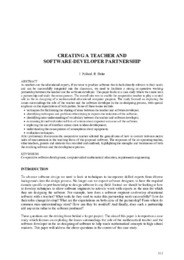Creating a teacher and software-developer partnership
Abstract
As teachers are the educational experts, if we want to produce software that is both directly relevant to their needs and can be successfully integrated into the classroom, we need to facilitate a strong co-operative working partnership between the teacher and the software developer. This paper looks at a case study where we create such a partnership and study the consequences. The overall aim was to enable the cooperative teacher to play a central role in the co-designing of a mathematical educational computer program. The study focused on exploring the issues surroundings the role of the teacher and the software developer in the co-designing process, with special emphasis on the expectations of both parties. Some of these issues include: • techniques for facilitating the sharing of ideas between the teacher and software developer;
• identifying techniques and problems when trying to express the task/aims of the software;
• identifying miss-understanding of vocabulary between the teacher and software developer;
• contrasting formal with informal lists of criteria about expected outcomes of the software;
• exploring the use of interface screen shots in ideas development;
• understanding the consequences of assumptions about equipment;
• evaluation techniques.
After preliminary discussions the cooperative teacher selected the general area of how to convert between metric units of measurement as the teaching focus of the proposed software. The responses of the co-operating teacher, other teachers, parents and students was recorded and analysed, highlighting the strengths and weaknesses of both the resulting software and the development process.
